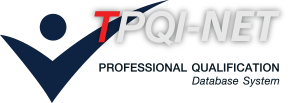หน่วยสมรรถนะ
Assess structural repair/modification requirements and evaluate structural.
สาขาวิชาชีพการบิน
รายละเอียดหน่วยสมรรถนะ
| 1. รหัสหน่วยสมรรถนะ | AVT-THUW-249A |
| 2. ชื่อหน่วยสมรรถนะ | Assess structural repair/modification requirements and evaluate structural. |
| 3. ทบทวนครั้งที่ | / |
| 4. สร้างใหม่ |
|
ปรับปรุง |
|
| 5. สำหรับชื่ออาชีพและรหัสอาชีพ (Occupational Classification) | |
|
7232 Aircraft engine mechanics and fitters |
|
| 6. คำอธิบายหน่วยสมรรถนะ (Description of Unit of Competency) | |
| This skill unit requires the interpretation of structural data repair and modification to determine the necessary measures and to determine compliance with airworthiness requirements or minor repairs performed structural changes. In addition, the color contrast performance penetrant non-destructive testing (NDT) on the applicable component is included. | |
| 7. สำหรับระดับคุณวุฒิ |
| 1 | 2 | 3 | 4 | 5 | 6 | 7 | 8 |
|---|---|---|---|---|---|---|---|
| 8. กลุ่มอาชีพ (Sector) | |
| 7232 Aircraft Mechanics | |
| 9. ชื่ออาชีพและรหัสอาชีพอื่นที่หน่วยสมรรถนะนี้สามารถใช้ได้ (ถ้ามี) | |
| N/A | |
| 10. ข้อกำหนดหรือกฎระเบียบที่เกี่ยวข้อง (Licensing or Regulation Related) (ถ้ามี) | |
| N/A | |
| 11. สมรรถนะย่อยและเกณฑ์การปฏิบัติงาน (Elements and Performance Criteria) |
| หน่วยสมรรถนะย่อย (EOC) | เกณฑ์ในการปฏิบัติงาน (Performance Criteria) | รหัส PC (ตามเล่มมาตรฐาน) |
รหัส PC (จากระบบ) |
|---|---|---|---|
| 102501.01 Assess structural repair or modification requirements. |
102501.01.01 Structural repair requirements are determined from maintenance manuals or approved repair schemes. Damage beyond repair scheme limits is referred to relevant personnel/authorities. |
102501.01.01 | 199616 |
| 102501.01 Assess structural repair or modification requirements. |
102501.01.02 Modification requirements are determined from approved drawings and specifications/ instructions or requirements are referred to relevant personnel/authorities, and completed work is evaluated for compliance with airworthiness requirements. |
102501.01.02 | 199617 |
| 102501.02 Perform colour contrast dye penetrant NDT. |
102501.02.01 Inspection requirements are identified from relevant maintenance data or to confirm a visually identified defect. Surfaces to be inspected are prepared for the dye penetrant process. Dye penetrant materials are selected in accordance with standard operating procedures, and penetrant test is performed in accordance with standard operating procedures and while observing all relevant work health and safety (WHS) precautions. |
102501.02.01 | 199622 |
| 102501.02 Perform colour contrast dye penetrant NDT. |
102501.02.02 Defect indications are checked and identified in accordance with standard operating procedures. Penetrant testing equipment is correctly maintained and stored while observing all relevant WHS requirements, Including the use of material safety data sheets (MSDS)and items of personal protective equipment (PPE), and results are recorded in accordance with standard enterprise and regulatory requirements. |
102501.02.02 | 199623 |
| 12. ความรู้และทักษะก่อนหน้าที่จำเป็น (Pre-requisite Skill & Knowledge) | |
|
N/A |
|
| 13. ทักษะและความรู้ที่ต้องการ (Required Skills and Knowledge) | |
|
(ก) ความต้องการด้านทักษะ N/A (ข) ความต้องการด้านความรู้ N/A |
|
| 14. หลักฐานที่ต้องการ (Evidence Guide) | |
|
(a) Performance Evidence (b) Knowledge Evidence |
|
| 15. ขอบเขต (Range Statement) | |
|
This field allows for different work environments and conditions that may affect performance. Essential operating conditions that may be present (depending on the work situation, needs of the candidate, accessibility of the item, and local industry and regional contexts) are included. |
|
| 16. หน่วยสมรรถนะร่วม (ถ้ามี) | |
| N/A | |
| 17. อุตสาหกรรมร่วม/กลุ่มอาชีพร่วม (ถ้ามี) | |
| N/A | |
| 18. รายละเอียดกระบวนการและวิธีการประเมิน (Assessment Description and Procedure) | |
|
• The assessment are based on combination of paper exams, interviewing, and practical demonstrations depending on the assessors’ judgement. |
|
